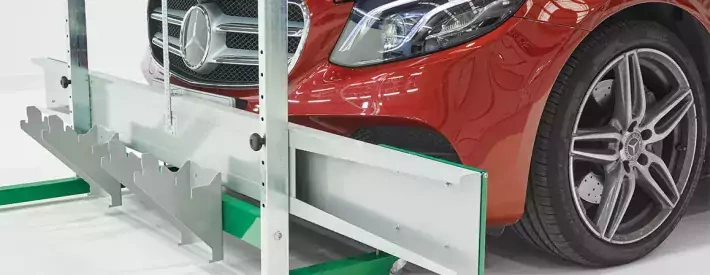How to reset your business for ADAS

It’s time to get ready for the intelligent cars that’ll soon be rolling into workshops. Here’s how…
Advanced driver-assistance systems (ADAS) are now fitted on hundreds of thousands of vehicles on our roads. It’s therefore imperative that the cameras and radars used by these complex systems are precisely calibrated to ensure their correct operation.
Ultrasonic sensors, medium, and long-range radar cameras and lidar are now used (often in unison) to control key safety features such as lane departure warnings, adaptive cruise control, emergency braking and steering assist. These days, there’s very little of a vehicle’s surroundings that goes unmonitored.
These features are all based on the relationship between a mechanical setting – the car’s axis, for example – and an electronic input. If the sensors are not calibrated correctly, then whatever systems the electronic control units (ECUs) adjust could respond with an incorrect action. That could prove incredibly dangerous.
Don’t skimp, start calibrating
As a result, ADAS calibration must be carried out following any accident repair, or windscreen replacement, but that’s not all. Everyday servicing and repair work such as replacing a steering or suspension component, as well as any adjustment made to the vehicle’s geometry, should also be followed by a careful recalibration. This was recently confirmed by Thatcham Research’s latest Insurance Industry Requirements.
Failure to recalibrate the ADAS could result in incorrect information being fed to the vehicle’s ECUs, potentially causing these vital safety features to operate inaccurately. That would pose an unacceptable risk to drivers and other road users.
After all, vehicle owners will need to have confidence that these systems are being recalibrated correctly and that the technician appreciates how critical this is.
Get up to speed
The question here isn’t whether or not ADAS checks and recalibration should be carried out (in short, they must). Rather, it’s about having the right knowledge and equipment to do it. Here’s a simple piece of advice for businesses and technicians: get your training up to date.
Once that’s done, you then have to understand that the original manufacturer’s calibration standards are final. Diagnostic tools need to follow the same calibration processes used by the manufacturer’s servicing network. At Hella Gutmann Solutions, that’s something all our equipment delivers.
Over the years, we’ve worked hard to position ourselves as a leader in ADAS calibration, and the likes of Thatcham Research, National Windscreens, Nationwide Windscreen Services and Autoglass now use our Camera and Sensor Calibration Tool.
That’s helping to establish the ADAS calibration standards that the whole sector should be meeting.
Spend money to make money
Calibration equipment is undoubtedly an investment, but it’s a good way for workshop owners to futureproof their businesses. It’ll help them stay competitive, and it also means they can rest easy knowing that every vehicle will be leaving the premises in a safe condition.
Of course, you don’t need to invest in every piece of calibration equipment at the outset. Perhaps consider starting with basic tools that will cater for popular vehicles in your area. That will provide an immediate revenue stream and enable you to expand your offering later.
ADAS technology is constantly evolving, so like other companies in this sector, we’re continually expanding our range with additional hardware and software upgrades to cover both existing systems and the new tools being introduced to the market. For example, we were the first firm to develop equipment enabling independent garages to calibrate Audi’s laser sensor and rear blind-spot unit.
ADAS is undoubtedly here to stay, so preparing now is vital. It could even help you build a more successful business in the future.




